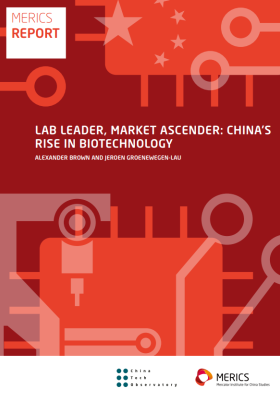
“The EU-China Comprehensive Agreement on Investment (CAI) is a test for the future trajectory of the EU-China relationship”
Before the end of the year, European countries will have to decide on an investment agreement with China. Last Friday, a tentative document was discussed at a meeting of ambassadors in Brussels, which is expected to be followed by top-level leaders’ discussion in the last days of December. The agreement promises improvements when it comes to reciprocity in Europe-China economic relations and market access for European companies in China. However, the (geo)political context and what’s not in the agreement does not make it the deal the European side had hoped for when negotiations started seven years ago. MERICS Director Mikko Huotari and MERICS Chief Economist Max J. Zenglein answer questions on the issue.


What’s at stake?
Mikko Huotari: The negotiations for the Comprehensive Agreement on Investment (CAI) represent the EU’s most important attempt to rebalance the EU-China economic relationship. While the CAI is an advanced version of a bilateral investment treaty (BIT) it cannot solve issues that are not part of the agreement. Nevertheless, concluding – or not concluding – the agreement would have wider political repercussions. Given the geopolitical context and current tensions in EU-China relations, the agreement should be seen as a test for the future trajectory of the relationship.
Even with a political decision to conclude the deal being taken, important details will still need to be hammered out in coming months and ratified, at least by the European Parliament.
Who will benefit from the deal?
Mikko Huotari: Europe has mostly been the demanding party in this negotiation, and China has made selective concessions that it considers in its own long-term interest. Looking at the scope of the agreement alone, it promises improvements for European actors regarding market access, non-discrimination and operating conditions in China. Relevant market opening commitments were made in financial services, telecommunications services, new energy vehicles, air and water transportation services, private hospitals, and research and development, among others.
Based on this deal, European companies active in these industries would indeed see new opportunities in China. The EU negotiators will have delivered for European business as the agreement potentially improves on a difficult status quo.
For Beijing, the agreement would provide it with a highly symbolic political win, demonstrating that China is in the business of globalization with major international partners, securing the continued interest of European investors and access to urgently needed technology. Chinese leaders will also appreciate that signaling a possible conclusion of the deal will complicate transatlantic rapprochement on China policy.
Despite all the possible shortcomings of the agreement, given the current level of tensions, the EU and China would both benefit from anchoring the relationship in a new contractual arrangement and understanding that both sides are able, in principle, to get to negotiated agreements, including on critical issues. At the same time, the agreement provides a rather sober reflection of the limitations of what can actually be achieved.
Can the investment agreement really improve the business environment for foreign companies?
Max J. Zenglein: The market access and level playing field promises of CAI need to be seen in the context of larger ongoing developments in China. Just a few days ago, the Chinese National Development and Reform Commission (NDRC) issued new regulations for investment scrutiny that are likely to at least partially contradict any future market opening. Chinese policy makers, responding to increased geopolitical risk and seeking to reach ambitious industrial upgrading targets, are currently reshaping the market environment for foreign companies in China. At this year’s “Central Economic Work Conference”, which was concluded on December 18, the Chinese leadership set clear priorities for a “whole-of-nation” system for developing greater national strategic scientific strength as well as technological autonomy and industrial supply chain resilience. Any further substantive market opening in China will materialize only if it helps Chinese leaders achieve these priorities.
More broadly, the Communist Party’s efforts to reassert control over the economy have accelerated in 2020. For example, companies are expected to localize their supply chains and shift R&D and higher value parts of their manufacturing processes to China. Foreign companies that do not comply with these expectations and do not make these adjustments could put their long-term business prospects at risk. The investment agreement cannot provide guardrails against such developments and leaves European companies exposing themselves to increased political influence.
What else does the agreement achieve (or not)?
Mikko Huotari: In the past months, next to additional market access commitments, major hurdles in the negotiation process have included “level playing field” issues, dispute settlement, labor rights and unique commitments on sustainability. On many of these issues, European negotiators have achieved progress, which can also benefit other like-minded partners. Transparency requirements for subsidies and SOE disciplines requiring them to operate on the basis of commercial considerations would represent significant steps forward. As with many legal commitments, enforceability and the actual grip of the dispute settlement architecture and “level playing field” clauses remain, however, to be tested. China has also not made substantial commitments regarding labor rights as enshrined in International Labor Organization (ILO) conventions which can be criticized in light of forced labor allegations in China and as a fair competition challenge.
The agreement was also never meant to touch on other issues that often lead to unfair competition, including for instance government procurement. Concluding the CAI now will require doubling the efforts to achieve progress on these issues in future.
What price is the EU potentially paying for this agreement?
Mikko Huotari: We do not know in detail what China will get out of this negotiation beyond the promise that Europe’s single market will continue to be open. It is possible that member states’ governments have also informally agreed on other issues, including those related to the roll-out of 5G, or investment and R&D cooperation promises in emerging technology sectors.
But there are bigger issues at stake. If Europe concludes this agreement, it is likely to lose some trust with like-minded partners including the U.S. who do not necessarily see this deal as a sign of Europe’s “strategic autonomy”. It would require shrewdness and a lot of political capital in Brussels and capitals to credibly pursue this dual-track approach of greater transatlantic coordination and a privileged relationship with China. And if the agreement stays in the current form (without substantial improvements on effective ILO commitments), Europe will also lose credibility as a normative and principled power – the price for more market access will be giving up on an admittedly limited opportunity to shape human rights developments and labor conditions in China. All European stakeholders should signal clearly to China that a deal without these commitments will not be put on the table for ratification.
It is unlikely that the EU alone, as an open economy, could easily apply greater leverage in these negotiations in order to induce China to offer further concessions. The coming months will show whether, while the CAI details might be put down on paper, relevant European leaders also seek alignment and greater leverage with like-minded partners with the same energy as they are currently pursuing the rapprochement with China.
Media Contact
The experts of the Mercator Institute for China Studies are available to comment on current news, as panelists or as op-ed authors.